A lot of people have pointed out the similarities between the events of The Epic of Gilgamesh and the Old Testament, mainly the massive flood that both describe. The similarities are striking at first: both Noah (in the Old Testament) and Utnapishtim (in Gilgamesh) survive worldwide floods in arks filled with animals; the primitive man Enkidu falls in much the same way Adam fell in the Garden; and Gilgamesh spends a lot of his eponymous epic seeking eternal life.
 Closer examination will initially make these similarities appear even stronger. For instance, Gilgamesh asks Utnapishtim for the secret of eternal life, to which the aged patriarch responds with a challenge: he tells Gilgamesh to stay awake for a week, and when Gilgamesh gives in to exhaustion Utnapishtim rhetorically asks, if you can't defeat sleep, how do you expect to defeat death itself? Eternal life, he says, is only obtainable as a free gift of the gods.
Closer examination will initially make these similarities appear even stronger. For instance, Gilgamesh asks Utnapishtim for the secret of eternal life, to which the aged patriarch responds with a challenge: he tells Gilgamesh to stay awake for a week, and when Gilgamesh gives in to exhaustion Utnapishtim rhetorically asks, if you can't defeat sleep, how do you expect to defeat death itself? Eternal life, he says, is only obtainable as a free gift of the gods.
Then there's the bit about Enkidu and Gilgamesh, the King of Sumeria/Babylon. Gilgamesh's quest for eternal life begins when his best friend Enkidu dies, and he goes to seek the help of Utnapishtim. In his grief, Gilgamesh becomes so distraught he ends up very animal-like, wandering the wilderness in skins and letting his hair grow disheveled. The scene is very reminiscent of another Babylonian king who plays a prominent Old Testament role, Nebuchadnezzar, whose madness manifested itself in the king's bestial behavior.
But at the most foundational level, The Epic of Gilgamesh and the Old Testament have little to nothing in common. Gilgamesh is basically the world's first fantasy novel; the Old Testament, on the other hand, is marked by its absolute realism. While there are miracles and supernatural events in the Old Testament, everything is told in such a straightforward manner that the reader never feels as though she's reading anything but historical fact.
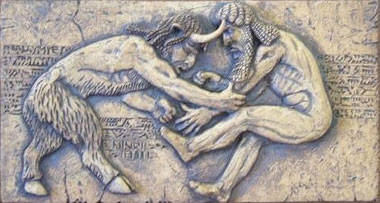 Anyone who feels that way about Gilgamesh is probably insane. Goddesses approach Gilgamesh—who roughly rebuffs and dismisses them; Gilgamesh and Enkidu fight an ogre named Humbaba and the Bull of Heaven; the two heroes cut down a gigantic cedar of Lebanon (the cedars of Lebanon also show up in the Old Testament) that's so big they make a gate out of it; and at one point Gilgamesh kills some stone-giants.
Anyone who feels that way about Gilgamesh is probably insane. Goddesses approach Gilgamesh—who roughly rebuffs and dismisses them; Gilgamesh and Enkidu fight an ogre named Humbaba and the Bull of Heaven; the two heroes cut down a gigantic cedar of Lebanon (the cedars of Lebanon also show up in the Old Testament) that's so big they make a gate out of it; and at one point Gilgamesh kills some stone-giants.
Occasionally, you'll hear Christian apologists putting forward The Epic of Gilgamesh as support for the validity of the Old Testament narrative. There are a lot of problems with that, but two seem most prominent: 1) Gilgamesh is the less reliable and more outlandish of the two texts; and, 2) the sources for Gilgamesh are far more disparate than those for the Old Testament, with different versions proliferating and lots of discrepancies.
Does that mean The Epic of Gilgamesh shouldn't be read? Of course not: it just means that it should only be read for what it is, a fantastic adventure story set in ancient Mesopotamia. A lot of great literature is ruined because people try to intellectualize it too much, or make it something it isn't. The best way (perhaps the only way) to really enjoy Gilgamesh is to acknowledge it as no more than some local color mythology that's still interesting and fun.
That's not to simply dismiss the epic, one of the oldest existing literary efforts, writing it off as an adventure story and nothing more. Like any great work of fiction, it investigates themes of human motivation, psychology, loyalty, friendship, the dangers of too much authority, etc. Most importantly, it explores the human desire for everlasting life, and the utter hopelessness of a life without hope or centered belief.
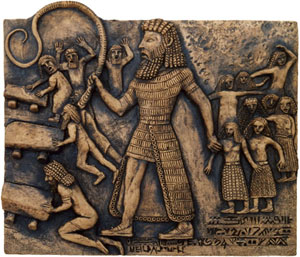 For Christian readers, this is probably the most important reason to read The Epic of Gilgamesh. Because we do have hope beyond the grave, hope extended to us by our savior Jesus Christ, we don't have to wander like Gilgamesh in an angsty quest for something we ultimately can't obtain. At the same time, we can easily lose sight of the plight of those without hope, and consequently we can lose compassion for them. Gilgamesh is a powerful reminder of the emptiness of life without faith.
For Christian readers, this is probably the most important reason to read The Epic of Gilgamesh. Because we do have hope beyond the grave, hope extended to us by our savior Jesus Christ, we don't have to wander like Gilgamesh in an angsty quest for something we ultimately can't obtain. At the same time, we can easily lose sight of the plight of those without hope, and consequently we can lose compassion for them. Gilgamesh is a powerful reminder of the emptiness of life without faith.
But it is an adventure story, too. The existential element puts it more in the category of London's The Sea Wolf or Hemingway's For Whom the Bell Tolls as opposed to something by Stevenson or Pyle, but it's filled with action and the kind of brooding soul-searching elements all the best adventure stories include. So there's no need to read The Epic of Gilgamesh the way you'd read a school book. Enjoy it for what it is, even while you let it reveal the innermost regions of the dark human heart.
Review by C. Hollis Crossman
C. Hollis Crossman used to be a child. Now he's a husband and father who loves church, good food, and weird stuff. He might be a mythical creature, but he's definitely not a centaur. Read more of his reviews
here.
ABOUT THE TRANSLATIONS

Click here to view an exclusive comparison chart comparing 4 translations of Gilgamesh!
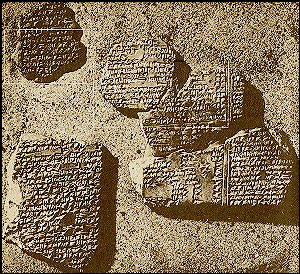 Unlike the Greek and Roman epics, Gilgamesh was not read by medieval thinkers, revered by Renaissance artists, or taught to 18th century schoolchildren. It was simply not around. Even though Gilgamesh is now hailed as the oldest story known to mankind, prior to 1853 the clay cuneiform tablets bearing the epic story lay buried deep in the ruins of an old Assyrian library. An Iraqi Christian named Hormuzd Rassam was the man who unearthed the first fragments, and over the years archaeologists continued to find more. Sudip Bose, in an article for the American Scholar, writes that the discovery of these old pieces “coincided roughly with the founding of Assyriology, the study of ancient Mesopotamia.”
Unlike the Greek and Roman epics, Gilgamesh was not read by medieval thinkers, revered by Renaissance artists, or taught to 18th century schoolchildren. It was simply not around. Even though Gilgamesh is now hailed as the oldest story known to mankind, prior to 1853 the clay cuneiform tablets bearing the epic story lay buried deep in the ruins of an old Assyrian library. An Iraqi Christian named Hormuzd Rassam was the man who unearthed the first fragments, and over the years archaeologists continued to find more. Sudip Bose, in an article for the American Scholar, writes that the discovery of these old pieces “coincided roughly with the founding of Assyriology, the study of ancient Mesopotamia.”
“As new manuscripts are discovered,” writes Assyriologist Andrew George in the introduction to his 1999 rendition, “this translation, like all others, will be superseded…the epic is indeed riddled with holes.” When translating the Gilgamesh story, scholars have to deal with sources from different time periods composed in different languages. This explains why George’s Gilgamesh is a little daunting to open. His translation is riddled with brackets, italics, and ellipses indicating lacunae—missing words or indecipherable chunks of text on the cuneiform tablets.
The first section of George's book contains the “Standard Version” of the story, while the second includes translations of various other Gilgamesh tablets which have been discovered over the years. A critic for the London Review of Books praises George for “skillfully [bridging] the chasm between a scholarly re-edition and a popular work.” One Amazon reviewer wrote: "So many translations are either painful transliterations, coming from someone who knows the language better than his mother tongue; or they are car-crash renderings into a stale 'academica-ese.' Andrew George manages to avoid the Scylla and Charybdis in this translation." As a result, we think this is the best translation for serious students or those who are interested in the history behind the excavation of the tablets.
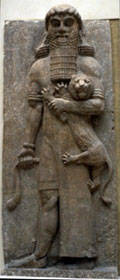 David Ferry’s 1992 translation is a slim book of verse with little introductory material and a very short notes section. Washington Post Book World’s Michaela Dirda praises Ferry for being the first translator to give us a rendition that is “as much poetry as scholarship.” This is probably the best version for younger scholars; Veritas Press prefers this edition and recommends it specifically in their Omnibus I curriculum, taught by Ben Merkle.
David Ferry’s 1992 translation is a slim book of verse with little introductory material and a very short notes section. Washington Post Book World’s Michaela Dirda praises Ferry for being the first translator to give us a rendition that is “as much poetry as scholarship.” This is probably the best version for younger scholars; Veritas Press prefers this edition and recommends it specifically in their Omnibus I curriculum, taught by Ben Merkle.
Stephen Mitchell's critically acclaimed 2004 version is a different sort of Gilgamesh. Mitchell admits in his introduction he can't read cuneiform and has no knowledge of Akkadian. He writes: "I have depended on the literal translations by seven scholars...My method was this: I first read and compared all the translations...cobbled together a rough prose version [and] began the real work, of raising the language to the level of English verse." Mitchell's primary source-text was George's literal translation, and he also referred to Ferry's poem frequently while composing his verse.
Known for his bestselling translations of The Book of Job and the Bhagavad Gita, Mitchell provokes varied reactions from his audience. He is not particularly interested in staying faithful to old texts, and his works bear witness to this: blatantly irreverent translations of sections the Bible, a modernized version of Lao-tzu's Tao Te Ching, and an Iliad with 1,000 lines cut out. Perhaps Mitchell is the perfect man to edit Gilgamesh—an unwieldy, fragmented saga which could use an artist's fresh interpretation. Still, readers should be aware that Mitchell's version is in places more sexually graphic than any of the other translations we carry.
N. K. Sandar's 1960 prose translation contains a long but easy-to-read introduction as well as a helpful glossary of names in the back. The introduction actually takes up the first half of the book, and Sandars makes a great effort to provide her readers with plenty of information on the literary and historical backgrounds of Gilgamesh. While her translation is not universally liked, Danel Jolley praises her for "remarkable job of putting the epic in its proper historical and literary perspective." While she is not an Assyriologist like George, a poet like Ferry, or a brazen editor like Mitchell, Sandar's Gilgamesh is good clear prose.
CHILDREN'S VERSIONS
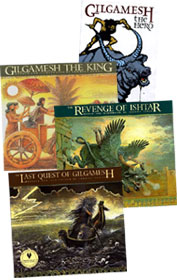 We carry Geraldine McCaughrean's Gilgamesh the Hero, illustrated by David Parkins. His art is colorful, bold and suits the rough, masculine nature of the story well. One caution: Enkidu, the "uncivilized beast" from the forest, is brought to civilization by Shamhat, a temple singer, who uses "feminine wiles" to lure him to her. There is fairly suggestive language in this scene and a picture including a small amount of nudity.
We carry Geraldine McCaughrean's Gilgamesh the Hero, illustrated by David Parkins. His art is colorful, bold and suits the rough, masculine nature of the story well. One caution: Enkidu, the "uncivilized beast" from the forest, is brought to civilization by Shamhat, a temple singer, who uses "feminine wiles" to lure him to her. There is fairly suggestive language in this scene and a picture including a small amount of nudity.
Ludmila Zeman split Gilgamesh up into three parts for children: Gilgamesh the King, Revenge of Ishtar, and Last Quest of Gilgamesh. These glossy paperbacks are better for little kids than Gilgamesh The Hero since they are more like traditional picture books. Zeman's illustrations have rich tones and convey Gilgamesh's adventures in a really beautiful way.
A third adaptation we've seen for children is Bernarda Bryson's 1966 Gilgamesh: Man's First Story, published by Holt, Rinehart, Winston. This one is more formal and old-fashioned than the other two, but it is also more comprehensive and more tasteful regarding the taming of Enkidu. Originally a large hardcover (now out of print and somewhat scarce), this has been reprinted more recently, in 2006 by Whole Spirit Press (9781892857019) and in 2012 by CreateSpace (9781477589861), but we've not seen these editions and can't vouch for their quality.
Did you find this review helpful?